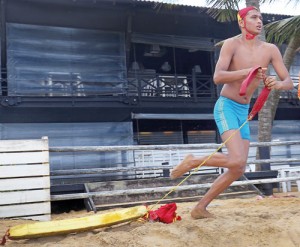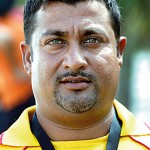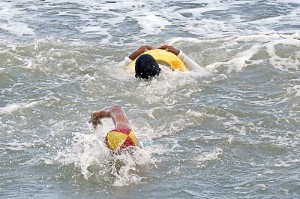Poson mission to save lives
While thousands of men, women and children flock to the sacred city of Anuradhapura as Poson Poya dawns on Tuesday, already on ‘duty’ along the picturesque Tissa Wewa are a bunch of schoolboys.

This is the way it’s done: A rescue operation in motion. Pix by M.A. Pushpa KumaraSequidellique nos mo
Having arrived two days before Poson all the way from Colombo, they have put up their makeshift tent with bare necessities, to rough out for three more days before returning home.
Headed by 17-year-old Pavithra Perera, the 11-member group on a life-saving mission, a different kind of ‘pilgrimage’, is from Nalanda College, Colombo. They are the Nalanda College Lifesaving Club.
In the past 20 years, during every single Poson, the Nalanda lifesavers have been on the lookout from 7 a.m. to 6 p.m. for any sign of bathers getting into troubled waters, to go to their aid.
The Nalanda lifesavers, along with several other groups, are assigned various duty-points by the Sri Lanka Lifesaving Association, as white-clad devotees, bearing trays of lotuses flock to Anuradhapura, wend their way around the Atamasthanaya and then camp close to the Nuwara Wewa or Tissa Wewa. There they would cook a meagre meal and take a dip in the tanks before heading for home in various corners of the country.
Thirty people the Nalanda lifesavers have rescued from drowning and it is Past Captain of the Club in 2011 and 2012, Sameera Vithanage, who recalls the huge crowds which throng the Tissa Wewa, making the task of the Nalandians doubly difficult.

Coach Roshan Wijesinghe
It is at a more regular positioning of the Nalanda lifesavers that we meet them on the lazy morning of last Sunday. Unlike the popular television series ‘Baywatch’ focusing on actors with rippling biceps glistening in the sun on the Los Angeles beach, there is a motley group of boys and youth on the Mount Lavinia beach, with some as young as 13 also in training.
As couples holding hands walk along the beach and families descend onto the sand to spread sheets and encourage their little ones to dip their feet in the surf, the history lesson on lifesaving for the younger members of the Nalanda Club is already over at the Sri Lanka Lifesaving Association Headquarters on the Mount Lavinia beach. Then it is time for exercises followed by a brisk walk along the beach to the site where they are on duty every single Sunday with the watch-hut behind them.
For the Nalanda lifesavers in their red-and-yellow uniforms and caps, there areno sleep-ins on a Sunday morning or other special holidays, tuition, family trips or even dhamma classes — “saving lives” they consider as their sacrosanct duty.
Tributes flow forth for the Nalandians from their coach, Roshan Wijesinghe, who is a National Coach of the Sri Lanka Lifesaving Team, as he informs us that Nalanda College was the first school to join the lifesaving service back in 1980.
“It’s not a sport, it’s a service,” he points out, adding that these days parents are more bent on getting their children into sports, but Nalandians have been different. Later one or two other schools had followed suit.
The Nalandians, meanwhile, have clearly portrayed their prowess, winning the National Lifesaving Championships two years running in 2012 and 2013, while Sameera has secured a world ranking in the under-19 category in Australia at ‘Rescue 2012’, the lifesavers’ world championships held every two years. In the 2014 championships in France, another Nalandian, Bhanuka Wijesundara was part of the team which won the bronze medal, a first for Sri Lanka.
“Lifesaving is a voluntary service where we work for the benefit of society,” says Sameera, explaining that lifesaving encompasses three components – it can be considered a sport, a source of education where we learn first-aid and a social service.
“The Nalandian lifesavers have also been called upon to help out during natural disasters such as the tsunami and flooding,” adds Mr. Wijesinghe.
The ‘recruitment’ of lifesavers at Nalanda comes when they are 13. They should be able to swim, with the steps to becoming a fully-fledged lifesaver covering the study of the history of lifesaving, acquiring first-aid skills and competitive training. It is a rigorous three-year course with three examinations they have to pass.
To be a qualified lifesaver in Sri Lanka, the minimum requirement is to be a bronze-medal holder, says Mr. Wijesinghe, adding that Nalanda has the largest number of bronzes, more than 200.
Last Sunday, as is usual, the Nalandians are in place at their spot, taking with them the essential torpedoes and the surf-board. As current Captain Pavithra whistles and signals from the shore, three boys swim out 100 metres to check the risks by looking into the ebb and flow of the waves, the direction of the current, where the rocks are and also any other danger spots such as sudden drops in the seabed.
Thereafter, the Nalandians hoist the relevant flags marking a certain extent of the beach. The red flags would warn swimmers against venturing into the water, but though on this overcast Sunday, the sea is rough, it is the red-and-yellow flags that go up, for it is safe for swimming.
As the huge waves crash onto the shore, Mr. Wijesinghe explains that even though the sea may look angry, the reconnaissance team has found no strong currents. Currents can be either surface or underwater and the most dangerous are the latter which include rip or deep currents, which can drag a human to his/her death. Rocks are also dangerous territory, for below them there could be unseen dangers.
The Sunday Times becomes privy to a quick demonstration how the young rescuers would respond in an emergency. Three juniors are sent out a little distance into the sea for the role-play of a drowning. When they bob up and down with hands waving in distress, two senior-rescuers jump into the water, taking with them torpedoes. Swimming up to them strongly, they throw the torpedoes to the ‘drowning victims’, while Sameera explains that otherwise the ‘victims’ will grab hold of the rescuers in desperation, taking them down as well.
Of the two types of rescues, ‘contact’ and ‘non-contact’, this is the latter. It is securely strapped into the torpedoes which make the victims float that they are brought back to the shore, to be pulled out by other helpful hands and then, if necessary, administered mouth-to-mouth resuscitation through pocket masks.
It is the newest and youngest recruit, Minoru Gunawardena, who puts the commitment and dedication of the Nalandians into perspective. “What greater thing can we do than saving lives,” he asks in all simplicity.
| Always on a Sunday Getting scorched by the sun or drenched by showers and sacrificing their precious Sundays, for the Nalandian rescuers satisfaction comes from saving lives……..and over the years they have saved 721. For Sameera who has won the two topmost awards, the Best Nalandian and Best Sportsman in 2013 (only one other had won it before in the history of Nalanda) a near-drowning in July 2012 is seared into his memory. When they were just about to end their duty, shouts of distress had sent Sameera and Chanuka Willarachchi swimming towards two people who were being dragged out to open sea. One of the victims, when brought to shore by them was alright, but the other was not breathing. Neither did he have a pulse, recalls Sameera, who immediately administered cardiopulmonary resuscitation (CPR or heart compression). “The worst is the advice and also abuse we were showered with by all the stragglers who had gathered around us,” says Sameera, adding that it becomes a hindrance to rescue efforts. Next, they loaded the victim onto a “kedichcha” (broken-down) Dimo-batta and rushed him to the Kalubowila Hospital, themselves still dripping water and Sameera missing his spectacles, lost in the melee. “They waited in their wet T-shirts and swimming trunks, until they heard that the man was okay,” adds Mr. Wijesinghe. Tips before you take a plunge Here is some advice to those who wish to spend a few leisure hours on the beach or close to a tank, stream or river. -If there are lifeguards, consult them before getting into the water. -If there are red flags indicative of danger don’t get into the water. -If there are flags indicating that it is safe to swim, check out whether there is good visibility and don’t go beyond the demarcated area. In rivers, look into the likelihood of crocodiles being in the water or on the banks. -Don’t take any alcohol, if planning to take a swim. -Don’t have a heavy meal before getting into the water. |


